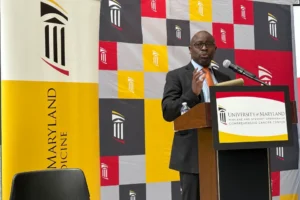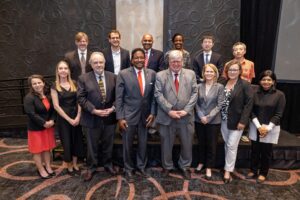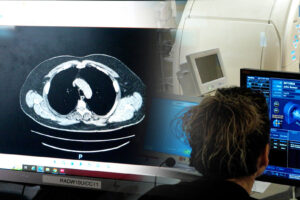MPower Professor Profile: Donald K. Milton, M.D., Dr.PH.

In November of 2021, University of Maryland, College Park President Darryll J. Pines and University of Maryland, Baltimore President Bruce E. Jarrell named eight professors as the inaugural MPower Professors. This award from the University of Maryland Strategic Partnership: MPowering the State (MPower) recognizes, incentivizes, and fosters faculty collaborations between the College Park and Baltimore campuses.
Selected for his commitment to interdisciplinary and interprofessional collaboration, Dr. Donald Milton is a Professor of Environmental Health at the University of Maryland, College Park (UMD) School of Public Health, and holds a secondary appointment in the University of Maryland, Baltimore (UMB) School of Medicine’s Department of Medicine. An internationally recognized expert on the aerobiology of respiratory viruses, Dr. Milton developed the concept of using indoor CO2 to directly measure rebreathed air and infection risk. He is the Principal Investigator of the UMD StopCOVID study (investigating SARS-CoV-2) and of the newly NIH-funded Evaluating Modes of Transmission (EMIT-2) study, a 5-year, $15 million UMD-UMD collaboration to perform randomized controlled trials that will define the modes and mechanisms of influenza transmission.
Can you briefly describe the type of research you do?
My research seeks to understand how people transmit respiratory viruses from person-to-person and how to effectively prevent transmission. I focus on determining the importance of airborne transmission for influenza, rhinovirus colds, and more recently COVID-19, relative to transmission by short range ballistic spray into eyes, nose, and mouth, and touching contaminated surfaces. I collaborate with engineers, aerosol scientists, virologists, biostatisticians, and other physicians to explore how well we can use ventilation, filtration, and germicidal ultraviolet light to prevent transmission of viral pathogens and keep people healthy and productive during influenza epidemics and control pandemics. A major goal is to identify and promote airborne infection controls that don’t depend on imposing individual behavior changes that work for us all of the time – even before we know that an outbreak is starting.
How do you gather data or conduct studies for your research?
All of the work that I do is as a member of large collaborative teams of dedicated researchers. Many of the studies we do are observational and focus on measuring virus in exhaled breath. We recruit people with COVID-19 or influenza to give samples (one or more of saliva, nasal swabs, exhaled breath, and blood), allow us to swab their mobile phone, and answer questionnaires about symptoms, exposures, vaccinations, etc. We collect exhaled breath aerosols with a Gesundheit-II (G-II for short) – a specially designed system that I developed 15 years ago with colleagues at the Harvard T. H. Chan School of Public Health. To collect their exhaled breath aerosols, infected persons sit in a booth with their face in a large cone that acts like the capture hood over a kitchen cooktop. The volunteer shouts “Go Terps!” and sings Happy Birthday multiple times while in the booth for 30 minutes. We count how many times they cough and sneeze. In many of our studies, we ask people to give two samples back-to-back, one while wearing a face mask or respirator and another without a face covering. In some studies, we collect samples on multiple days. We use PCR to measure the number of viral genome copies in the saliva, swabs, and breath samples and use cell culture to determine whether the virus we detect by PCR is actually infectious. We also sequence the viruses to identify virus strains and variants. In some studies, we collect air samples in the homes where study participants live to determine how much virus others sharing the residence could be inhaling. We collaborate with engineering colleagues who measure concentrations of carbon dioxide and particle matter in the air of buildings occupied by our study participants. Then, working as a team of geographers, engineers, epidemiologists, and biostatisticians, we analyze the data for associations between indoor air quality and risk of infection transmission.
What drives you to do this research?
My initial interest grew out of my work as a practicing environmental and occupational medicine physician. I saw many patients who reported frequent work- or building-related colds and flu like illnesses. Some of them developed asthma that seemed to be driven by poor indoor air quality. I especially remember an outbreak of new, adult-onset asthma in a cluster of people working together in a poorly ventilated room; one of whom died, at home clutching her inhaler, unable to work due to her asthma. Throughout my career I’ve been focused on prevention. But that indelible image and the failure of medical treatments to save my patient keeps me focused on the importance of indoor air. More than 90% of the air that we breathe during our lifetime is indoor air.
The other driver for me has been the realization, starting with expert consultation meetings for CDC following the anthrax attacks in 2001, that healthcare infection control, biodefense, and pandemic response plans were not well grounded in an understanding of airborne transmission. Pandemic response plans at local, state, and national levels failed to address making indoor space safe and instead merely advocated masks and shutdowns. Without stronger evidence for airborne transmission, advocating for a focus on indoor air as a part of a pandemic plan went nowhere. A paper I wrote about the potential for airborne transmission of smallpox was rejected in 2003 with reviewers charging that I was a quack and charlatan. The plans didn’t change; when COVID-19 hit, we implemented widespread school closures and broad economic shutdowns. We never want to do that again if there are any viable alternatives—but how can we avoid that without seeing an even more terrible death toll if we get hit with a highly transmissible and virulent pathogen? It is my hope that by understanding how pandemic viruses spread, the role of airborne transmission, and with solid evidence of the effectiveness of ventilation, filtration, and air disinfection, we can motivate widespread use of technologies to make homes, schools, and workplaces healthier places to be all of the time, and make our country more resistant and resilient to future respiratory viral pandemics.
What did it mean to you personally to be named an MPower Professor?
I feel greatly honored and encouraged that our University chose to use the MPower Professorships to lift up collaborative, cross-campus work. The future of science lies, and has always been, at the intersection of different ways of thinking. Many of the most significant new ideas and advances, I believe, will come as we strive to move from cross-disciplinary, multidisciplinary and even interdisciplinary collaborations to the emergence of transdisciplinary insights and perspectives. I long struggled with how to describe myself and my research discipline—am I a physician clinical researcher, a physiologist, an epidemiologist, an aerobiologist? I see myself as an environmental health scientist. Environmental Health Sciences are in reality too broad for any one person to encompass and demand wide collaborations to make progress. With this honor, I feel validated for taking a path less trodden with great hopes that others too will be inspired to seek new approaches to humanity’s many challenges.
How do you collaborate with researchers outside of your discipline?
I work closely with engineers and aerosol scientists to design and build new air sampling devices and implement interventions, with computational fluid dynamic modelers to design experiments and analyze data, with virologists and immunologist to measure and understand viral infections and immune reactions, with epidemiologists, geographers and biostatisticians to design and analyze human studies, and with health equity, environmental justice, health communications and literacy experts to see that our research is translated into practice.
Why is this collaboration important to you?
My work is fundamentally transdisciplinary—meaning that advances in understanding respiratory viral transmission grow not merely out of individual fields or even collaboration among different fields, each working on separate parts of a problem. Major advances in this research come only when emergent insights arise out of the confluence of multiple research disciplines. During the COVID-19 pandemic, it was emerging insights arising from work across many disciplines that convinced the vast majority of the scientific and medical communities that COVID-19 is airborne. Much work remains to be done to reach consensus regarding the modes of transmission of influenza, RSV, rhinovirus, and many other respiratory pathogens.
Please name the researchers you have worked with on MPower collaborations:
UMB: Wilbur Chen, Justin Ortiz, Kathleen Neuzil, Matthew Frieman, Kristen Mullins
UMD Clark School of Engineering: Jelena Srebric, Don DeVoe, Greg Duncan, Kevin Daniels, Min Wu, Jeffrey Herrmann
UMD College of Computer, Mathematical, and Natural Sciences: Margaret Scull, Adam Porter, Ashok Agrawala
UMD College of Behavioral and Social Sciences: Kathleen Stewart
How do the funds awarded from MPower support your research and help facilitate collaborations with other researchers?
MPower funds are being used to support teaching and outreach about the importance of breathing clean air through supporting UMD undergraduates to build, and to teach community members to build, Corsi-Rosenthal (DYI) indoor air filters. Through our collaborations with the Center for Health Equity we are distributing the filters to local barbershops, beauty salons, religious meeting houses and individual homes. Students are also taking them back to their own rooms. We are also using funds to purchase germicidal ultraviolet lights for research and demonstration projects and to provide an additional layer of protection for events. These outreach and communication activities will also support recruiting research participants for the major joint UMD-UMB intervention trial that will launch this winter.
What are the next steps for your research?
We are transitioning from observational studies into two types of intervention studies.
The first and largest project will use interventions to selectively block different routes of transmission as a means of defining the relative importance of aerosol inhalation, spray deposition, and touch in transmission of influenza. We will recruit people who are susceptible to influenza and ask them to stay in a hotel quarantine for a couple of weeks. During that time, we will ask them to spend several days in a room with people infected with influenza virus. The indoor air quality in the exposure room is highly controlled and monitored by our engineering colleagues. Some of the “Recipients” wear face shields and use hand sanitizer frequently and others do not. Sometimes we will clean and disinfect the air extensively with filters or germicidal ultraviolet light, other times we reproduce poor ventilation conditions that are still too commonly seen in residential and some public buildings. We will collect exhaled breath from the “Donor” influenza cases to monitor how much virus they are shedding into the air. We will also collect room air to monitor the amounts of virus that the Recipients are breathing. We will collect frequent symptom questionnaires and swabs for virus testing from the “Recipients” during the two weeks they are in the hotel and blood several weeks later for antibody testing.
The second type of study will be intervention studies to assess the real-world effectiveness of germicidal ultraviolet light in restaurants and occupational settings. We will monitor infection among people visiting the restaurant and workers—some with the intervention active and others with sham interventions.



